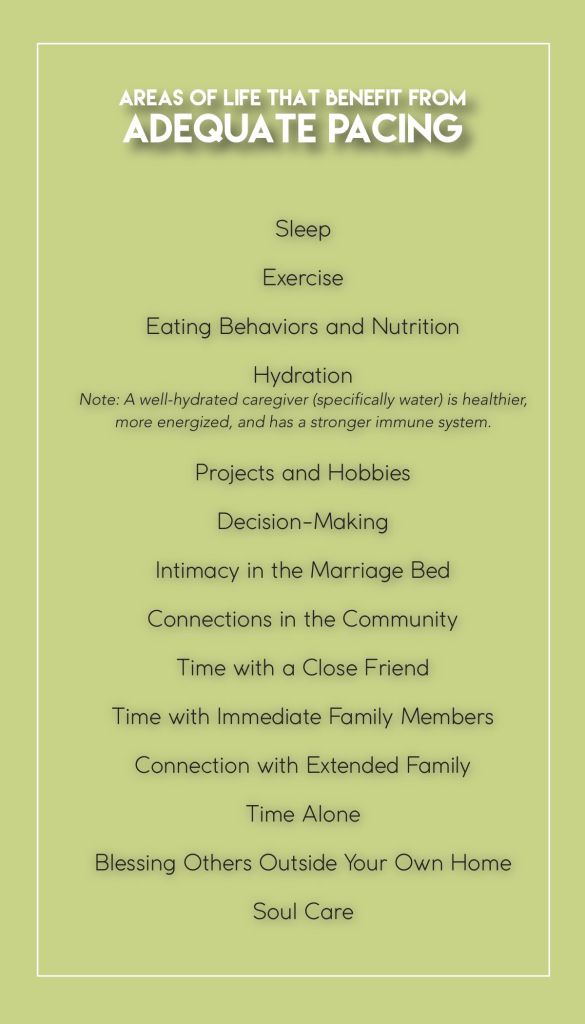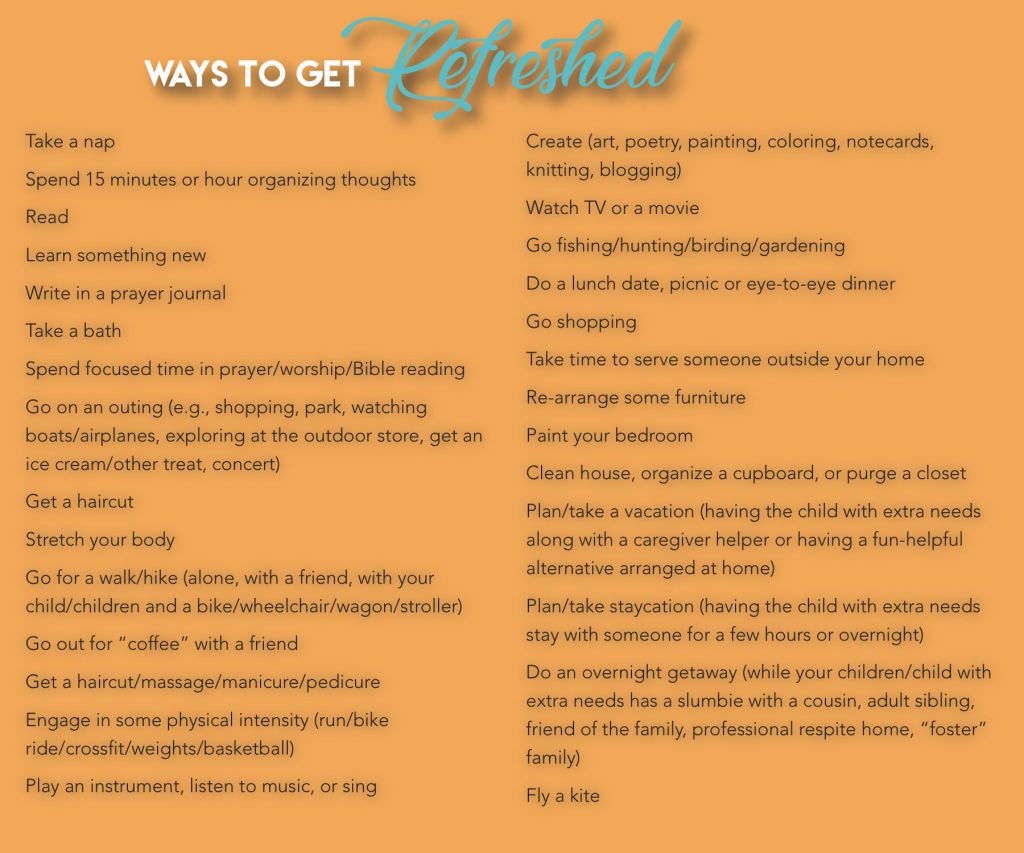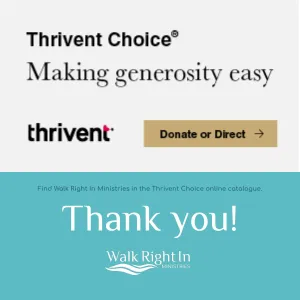
This post is part of an ongoing conversation here at the blog about the 8 Habits of Caregivers with a Robust Support System. We have been revisiting each of the habits with stories and tips on each one. Again today, we’ve been focusing specifically on Habit #6: Find your pace for an adequate rhythm of respite.
The goal of developing an adequate respite rhythm is to maintain reasonable health and well-being. A looming question then is:
How much respite is enough respite?
Unfortunately, the intensity of caregiving required of some parents and family caregivers doesn’t allow for anything close to the ideal lifestyle we need or hope to enjoy. But some reasonable degree of rest and refreshment must be achieved. It’s a matter of physical, emotional, spiritual, and relational health for the caregiver as well as quality of life for a family and the one needing the aid of others.

Not every activity or respite strategy brings equal amounts of refreshment. And there is no quantifiable formula that equates to enough. I have a personal story that may serve to bring some perspective as you figure out your own unique and personalized rhythm. But before I share the story, allow me to encourage you to enjoy some experimenting. Managing respite is a skill to be honed. It’s a learning process that benefits from some trial-and-error in several key areas of life.
Create a list of activities that feel, to any degree, replenishing. Keep it handy (maybe a note in your phone) so you can add new ideas at any time. Consider asking your loved ones if they have noticed any specific activities that seem to energize you. Their answers may surprise you or enlighten your future choices.
Ask other family caregivers what would be on their lists too.


Don’t let tight finances keep you from discovering a creative approach. Just the other day my friend posted a photo on social media demonstrating how to set up a romantic tailgate picnic in the back of your care. That’s now on my To DO list!
We have the option to pace ourselves for the long-haul or to live our days in tension, fear of running out of steam, outright panic, at risk of injury or headed toward burnout. This requires some self-awareness and taking a close, honest look at our own areas of strength, limitation and vulnerability — accepting that each one of us is a combination of those.
Pay attention to what is really triggering your stress. If you simply lump all of your overwhelm into a single bucket called “stress,” you may not get to the root reason underlying your fatigue or anxiety.Stress builds for such a variety of reasons: lack of sleep, repressed grief, feeling unheard, control issues, lack of boundaries, perfectionism, and difficulty trusting God.
Pay attention to what is really triggering your stress.
We respond differently to people and situations when we are rested. Be intentional about noticing how you react to your responsibilities — emotionally and behaviorally — during the hours or days before to getting a break. Then pay equally close attention to how you react — internally and externally — during the hours and days after you return from a break. Taking an opportunity to step away brings perspective and allows for a reset.
When it comes to getting breaks from caregiving responsibilities, we often have to plan ahead and then hold our expectations loosely at our house. We try to make plans for breaks with some degree of regularity whether that respite looks like a nap in the middle of the day, time alone to organize thoughts, exercise to decompress, a few hours away for a haircut and errands, a lunch date, spontaneous or planned intimacy in the marriage bed, an overnight getaway, or a vacation.
Each of us needs enough time alone. We also need enough time as a couple, enough time with each of our children, and enough time as a family together. As our adult children have moved into independent lives, that family time is an extra gift but well worth praying for and being creative about.
A note about intimacy: Some couples need to experience sexual intimacy twice a week to maintain satisfying connection. Another couple may find that monthly is adequate for them. Marriage in a caregiving family will likely require many compromises and generous amounts of creativity.
Many years ago, I was away at a weekend scrapbooking retreat with friends. Many of those women were avid scrapbookers who spent a certain amount of time throughout the year working on their projects. For me, it was a once-a-year opportunity. I really needed the time with friends. But I desperately wanted time to sit in my own thoughts for a while too looking at pictures and being super-efficient about creating my albums. Finding my rhythm for a satisfying weekend was tricky.
Those women were creating such fun pages of memories. By the end of the weekend, they would finish 15 or 20 gorgeously detailed pages. Though I was both inspired, I chose another approach — fast and cheap!

Because efficiency is always my tendency and this was such rare time for me after Carly was born, I would go into the weekend hoping to finish at least one entire book filled with 40 pages or more. One year I completed two full books for my daughter Alex’s keepsakes — one book from birth to elementary school and one book reflecting her middle school years. I was on a mission!
The other ladies sometimes teased me for being so driven. And I’m sure I was prideful about it sometimes. I also got stuck at times, stalling out of my hyper-efficient rhythm. I would lean back in my chair and whine in frustration for all to hear. Oh, the grace those dear women had for me!
One day I expressed frustration that I wasn’t staying on pace with my productivity goals. A dear friend across the room called out the perfect words to get me going again. She said, “Remember Lisa, done is better than perfect!”
Everyone had a good laugh. Meanwhile, that was a precious reminder and encouragement to me. She understood. I didn’t have the luxury of getting too bogged down in details or too caught up in creative ideas (even though I absolutely love creativity and details). But the life I’ve been given has shifted my values and shown me I can be very happy with leaning into different priorities.
So, I pulled myself back up to my cutting table and got back to work producing at least four pages an hour through the rest of the weekend.
That phrase became a cheerful motto for future scrapbooking weekends. It also became a very helpful mindset when applied to life and other projects over the years. Most importantly, it has applied to taking breaks from caregiving. Larry and I have had to adapt too many romantic getaway plans to count over the years. But never once have we regretted pressing on with revisions and getting the break anyway, even if it seemed quite inferior from the original dream.
So, how much respite is enough respite?
When it comes to finding our respite rhythms, some is better than none, and DONE is better than perfect.
Philippians 4:11-13
I have learned to be content whatever the circumstances. I know what it is to be in need, and I know what it is to have plenty. I have learned the secret of being content in any and every situation, whether well fed or hungry, whether living in plenty or in want. I can do all this through Christ who gives me strength.
RELATED: Seven Ways to Energize & Refresh Your Special Needs Family
RELATED: Best Practices of Refreshed Special Needs Moms
WATCH: Flourishing Families with Matt Mooney.
RELATED: Can Caregivers Expect Something Out-of-this-World?
Watch for the final instalment in this 3-part mini-series coming next week — Respite Rhythms (Part 3): Pace Yourself! We’ve got a bunch of practical pacing tips coming so visit the blog again next week. We’d love to hear ideas from you too. Share them what’s been working for you in the comments or contact us privately.

Lisa Jamieson is a caregiver consultant, pastoral counsellor and author of popular books and Bible studies including Finding Glory in the Thorns and Jesus, Let’s Talk. Lisa and her husband, Larry, live in Minnesota with the youngest of their three grown daughters, Carly, who has Angelman Syndrome. Together, the Jamiesons founded Walk Right In Ministries in 2008, a non-profit organization building faith and community with special needs families.










0 Comments